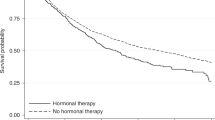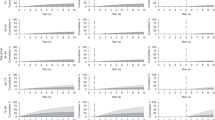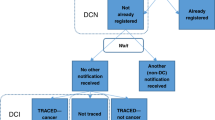Abstract
Background
Routine reporting of cancer patient survival is important, both to monitor the effectiveness of health care and to inform about prognosis following a cancer diagnosis. A range of different survival measures exist, each serving different purposes and targeting different audiences. It is important that routine publications expand on current practice and provide estimates on a wider range of survival measures. We examine the feasibility of automated production of such statistics.
Methods
We used data on 23 cancer sites obtained from the Cancer Registry of Norway (CRN). We propose an automated way of estimating flexible parametric relative survival models and calculating estimates of net survival, crude probabilities, and loss in life expectancy across many cancer sites and subgroups of patients.
Results
For 21 of 23 cancer sites, we were able to estimate survival models without assuming proportional hazards. Reliable estimates of all desired measures were obtained for all cancer sites.
Discussion
It may be challenging to implement new survival measures in routine publications as it can require the application of modeling techniques. We propose a way of automating the production of such statistics and show that we can obtain reliable estimates across a range of measures and subgroups of patients.
This is a preview of subscription content, access via your institution
Access options
Subscribe to this journal
Receive 24 print issues and online access
$259.00 per year
only $10.79 per issue
Buy this article
- Purchase on Springer Link
- Instant access to full article PDF
Prices may be subject to local taxes which are calculated during checkout



Similar content being viewed by others
Data availability
Due to privacy protection rules the data cannot be publicly shared.
Code availability
The code used for generating the results can be accessed at https://github.com/CancerRegistryOfNorway/cancer-survival-measures. This page also contains additional material, including simpler example code using a publicly available dataset.
References
Ferlay JEM, Lam F, Colombet M, Mery L, Piñeros M, Znaor A, et al. Global cancer observatory: cancer today. Lyon, France: International Agency for Research on Cancer; 2020. https://gco.iarc.fr/today.
Dickman PW, Adami HO. Interpreting trends in cancer patient survival. J Intern Med. 2006;260:103–17.
Putter H, Fiocco M, Geskus RB. Tutorial in biostatistics: competing risks and multi-state models. Stat Med. 2007;26:2389–430.
Andersson TM, Dickman PW, Eloranta S, Lambe M, Lambert PC. Estimating the loss in expectation of life due to cancer using flexible parametric survival models. Stat Med. 2013;32:5286–300.
Cancer Registry of Norway. Cancer in Norway 2021—cancer incidence, mortality, survival and prevalence in Norway. Oslo: Cancer Registry Norway; 2022.
Larsen IK, Smastuen M, Johannesen TB, Langmark F, Parkin DM, Bray F, et al. Data quality at the Cancer Registry of Norway: an overview of comparability, completeness, validity and timeliness. Eur J Cancer. 2009;45:1218–31.
Nelson CP, Lambert PC, Squire IB, Jones DR. Flexible parametric models for relative survival, with application in coronary heart disease. Stat Med. 2007;26:5486–98.
Syriopoulou E, Mozumder SI, Rutherford MJ, Lambert PC. Robustness of individual and marginal model-based estimates: a sensitivity analysis of flexible parametric models. Cancer Epidemiol. 2019;58:17–24.
Andersson TM, Rutherford MJ, Lambert PC. Illustration of different modelling assumptions for estimation of loss in expectation of life due to cancer. BMC Med Res Methodol. 2019;19:145.
Brenner H, Gefeller O. An alternative approach to monitoring cancer patient survival. Cancer. 1996;78:2004–10.
Myklebust TA, Aagnes B, Moller B. An empirical comparison of methods for predicting net survival. Cancer Epidemiol. 2016;42:133–9.
Syriopoulou E, Rutherford MJ, Lambert PC. Marginal measures and causal effects using the relative survival framework. Int J Epidemiol. 2020;49:619–28.
Perme MP, Stare J, Esteve J. On estimation in relative survival. Biometrics. 2012;68:113–20.
Myklebust T, Aagnes B, Nilssen Y, Johansson A, Rutherford M, Andersson T, et al. Extending standard reporting to improve communication of survival statistics. Cancer Registry of Norway; 2022. https://www.kreftregisteret.no/Generelt/Rapporter/Cancer-in-Norway/cancer-in-norway-2021/.
StataCorp. Stata Statistical Software: Release 17. College Station, TX: StataCorp LLC; 2021.
Lambert P. STPM2: Stata module to estimate flexible parametric survival models. 2020.
Lambert P. STANDSURV: Stata module to compute standardized (marginal) survival and related functions. 2021.
Armstrong BK. The role of the cancer registry in cancer control. Cancer Causes Control. 1992;3:569–79.
Lambert PC, Andersson TM, Rutherford MJ, Myklebust TA, Moller B. Reference-adjusted and standardized all-cause and crude probabilities as an alternative to net survival in population-based cancer studies. Int J Epidemiol. 2020;49:1614–23.
Cronin KA, Feuer EJ. Cumulative cause‐specific mortality for cancer patients in the presence of other causes: a crude analogue of relative survival. Stat Med. 2000;19:1729–40.
Lambert PC, Dickman PW, Rutherford MJ. Comparison of different approaches to estimating age standardized net survival. BMC Med Res Methodol. 2015;15:1–13.
Candido dos Reis FJ, Wishart GC, Dicks EM, Greenberg D, Rashbass J, Schmidt MK, et al. An updated PREDICT breast cancer prognostication and treatment benefit prediction model with independent validation. Breast Cancer Res. 2017;19:1–13.
Mozumder SI, Dickman PW, Rutherford MJ, Lambert PC. InterPreT cancer survival: a dynamic web interactive prediction cancer survival tool for health-care professionals and cancer epidemiologists. Cancer Epidemiol. 2018;56:46–52.
Yu XQ, De Angelis R, Andersson TM, Lambert PC, O'Connell DL, Dickman PW. Estimating the proportion cured of cancer: some practical advice for users. Cancer Epidemiol. 2013;37:836–42.
Löffeler S, Halland A, Weedon-Fekjær H, Nikitenko A, Ellingsen CL, Haug ES. High Norwegian prostate cancer mortality: evidence of over-reporting. Scand J Urol. 2018;52:122–8.
Skyrud KD, Bray F, Møller B. A comparison of relative and cause‐specific survival by cancer site, age and time since diagnosis. Int J Cancer. 2014;135:196–203.
Lash TL, Riis AH, Ostenfeld EB, Erichsen R, Vyberg M, Thorlacius‐Ussing O. A validated algorithm to ascertain colorectal cancer recurrence using registry resources in Denmark. Int J Cancer. 2015;136:2210–5.
Smith A, Lambert PC, Rutherford MJ. Generating high-fidelity synthetic time-to-event datasets to improve data transparency and accessibility. BMC Med Res Methodol. 2022;22:176.
Jordon J, Yoon J, Van Der Schaar M, editors. PATE-GAN: generating synthetic data with differential privacy guarantees. International conference on learning representations; 2019. https://openreview.net/group?id=ICLR.cc/2019/Conference.
Author information
Authors and Affiliations
Contributions
TÅM planned the study, analyzed the data and drafted the manuscript. BA planned the study, analyzed the data, and critically reviewed manuscript drafts. YN planned the study, analyzed the data, and critically reviewed manuscript drafts. MR planned the study, and critically reviewed manuscript drafts. PCL planned the study, and critically reviewed manuscript drafts. TMLA planned the study, and critically reviewed manuscript drafts. ALVJ planned the study, and critically reviewed manuscript drafts. PWD planned the study, and critically reviewed manuscript drafts. BM planned the study, and critically reviewed manuscript drafts.
Corresponding author
Ethics declarations
Competing interests
The authors declare no competing interests.
Ethical approval
All analysis were performed at the Cancer Registry of Norway (CRN), which is statutory, and statistics were made available according to the Norwegian Health Register Act §19. Ethical approval was not required for the produced statistics.
Additional information
Publisher’s note Springer Nature remains neutral with regard to jurisdictional claims in published maps and institutional affiliations.
Supplementary information
Rights and permissions
Springer Nature or its licensor (e.g. a society or other partner) holds exclusive rights to this article under a publishing agreement with the author(s) or other rightsholder(s); author self-archiving of the accepted manuscript version of this article is solely governed by the terms of such publishing agreement and applicable law.
About this article
Cite this article
Myklebust, T.Å., Aagnes, B., Nilssen, Y. et al. Improving communication of cancer survival statistics—feasibility of implementing model-based algorithms in routine publications. Br J Cancer 129, 819–828 (2023). https://doi.org/10.1038/s41416-023-02360-5
Received:
Revised:
Accepted:
Published:
Issue Date:
DOI: https://doi.org/10.1038/s41416-023-02360-5



